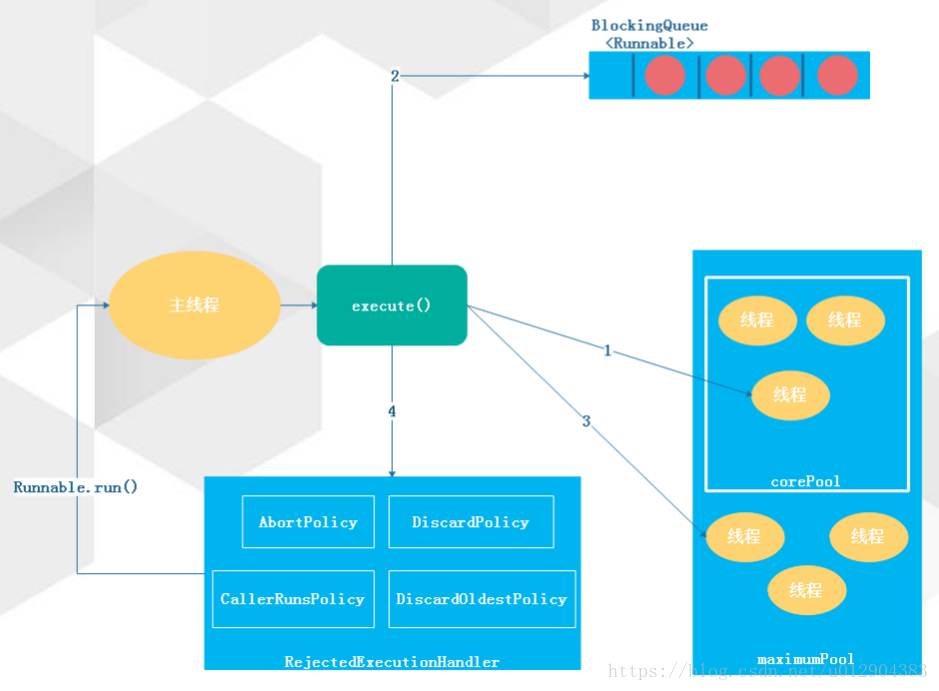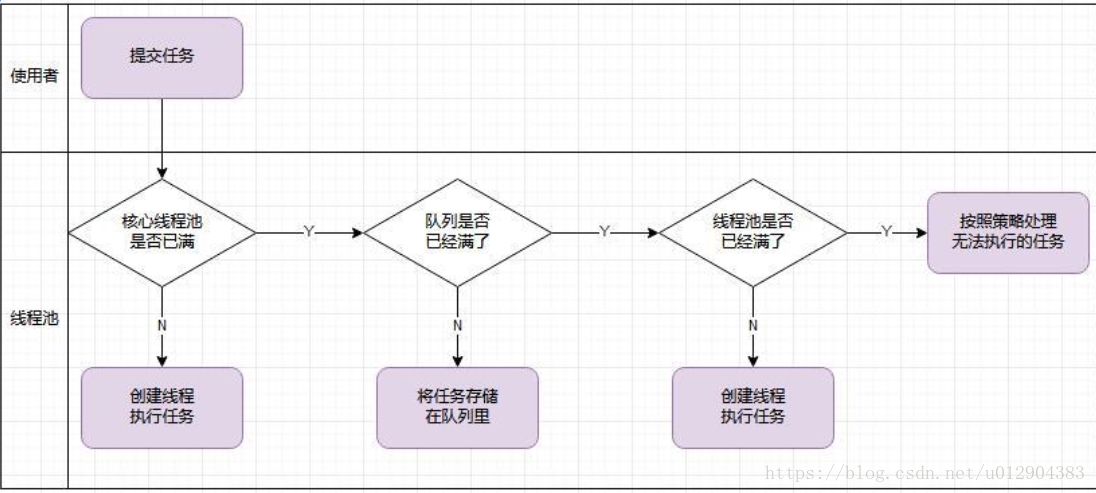一、为什么需要线程池
随着系统用户的逐渐增多,为了提高用户响应,提供一个高并发,高可用的系统。java的线程池就可以解决很多问题。很多异步,并发的场景都可以用到线程池。
1.降低重复创建线程的开销,统一管理线程。
2.提高响应速度,任务提交后,不需要等待线程创建的过程。
3.提高线程的可管理性。重复管理线程,避免创建大量的线程增加开销。
二、线程池的处理流程
1.线程池构造参数
private static final RejectedExecutionHandler defaultHandler = new AbortPolicy();
private final BlockingQueue<Runnable> workQueue;
private final ReentrantLock mainLock = new ReentrantLock();
private final HashSet<Worker> workers = new HashSet<Worker>();
private volatile long keepAliveTime;
private volatile boolean allowCoreThreadTimeOut;
private volatile int corePoolSize;
private volatile int maximumPoolSize;
private volatile RejectedExcutionHandler handler;
public ThreadPoolExecutor(int corePoolSize,
int maximumPoolSize,
long keepAliveTime,
TimeUnit unit,
BlockingQueue<Runnable> workQueue,
ThreadFactory threadFactory,
RejectedExecutionHandler handler) {
if (corePoolSize < 0 ||
maximumPoolSize <= 0 ||
maximumPoolSize < corePoolSize ||
keepAliveTime < 0)
throw new IllegalArgumentException();
if (workQueue == null || threadFactory == null || handler == null)
throw new NullPointerException();
this.corePoolSize = corePoolSize;
this.maximumPoolSize = maximumPoolSize;
this.workQueue = workQueue;
this.keepAliveTime = unit.toNanos(keepAliveTime);
this.threadFactory = threadFactory;
this.handler = handler;
}
|
corePoolSize | 核心运行的poolSize,也就是当超过这个范围的时候,就需要将新的Thread放入到等待队列中了 |
|---|---|
| maximumPoolSize | 线程池最大容量大小,当大于了这个值就会将Thread由一个丢弃处理机制来处理 |
| keepAliveTime | 默认都是0,当线程没有任务处理后,保持多长时间 |
| TimeUnit | 时间单位, |
| ThreadFactory | 是构造Thread的方法,你可以自己去包装和传递,主要实现newThread方法即可 |
| BlockingQueue | 等待队列,当达到corePoolSize的时候,就向该等待队列放入线程信息(默认为一个LinkedBlockingQueue),运行中的队列属性为:workers,为一个HashSet;内部被包装了一层 |
| RejectedExecutionHandler | 参数maximumPoolSize达到后丢弃处理的方法,java提供了4种丢弃处理的方法,当然你也可以自己弄,主要是要实现接口:RejectedExecutionHandler中的方法 |
2.处理流程
主要步骤:当提交一个任务到线程池时,线程池会创建一个线程来执行任务,即使其他空闲的基本线程能够执行新任务也会创建线程,等到需要执行的任务数大于线程池基本大小时就不再创建。如果调用了线程池的prestartAllCoreThreads()方法,线程池会提前创建并启动所有基本线程。然后将任务提交到队列,如果队列满了,并且已创建的线程数小于最大线程数,则线程池会再创建新的线程执行任务。值得注意的是,如果使用了无界的任务队列这个参数就没什么效果。当队列和线程池都满了,说明线程池处于饱和状态,那么必须采取一种策略处理提交的新任务。这个策略默认情况下是AbortPolicy,表示无法处理新任务时抛出异常。
三、ThreadPoolExecutor
1.具体执行方法

有一个重要的变量:
private final AtomicInteger ctl = new AtomicInteger(ctlOf(RUNNING, 0));
ctl维护两个概念上的参数:workCount和runState。
workCount表示有效的线程数量,
runState表示线程池的运行状态。
public void execute(Runnable command) {
//检查command不能为null
if (command == null)
throw new NullPointerException();
/*
* Proceed in 3 steps:
*
* 1. If fewer than corePoolSize threads are running, try to
* start a new thread with the given command as its first
* task. The call to addWorker atomically checks runState and
* workerCount, and so prevents false alarms that would add
* threads when it shouldn't, by returning false.
*
* 2. If a task can be successfully queued, then we still need
* to double-check whether we should have added a thread
* (because existing ones died since last checking) or that
* the pool shut down since entry into this method. So we
* recheck state and if necessary roll back the enqueuing if
* stopped, or start a new thread if there are none.
*
* 3. If we cannot queue task, then we try to add a new
* thread. If it fails, we know we are shut down or saturated
* and so reject the task.
*/
int c = ctl.get();
//如果当前线程小于corePoolSize
if (workerCountOf(c) < corePoolSize) {
//如果添加Worker线程成功,则返回
if (addWorker(command, true))
return;
c = ctl.get();
}
//如果当前正在运行阶段并且可以将线程入队
if (isRunning(c) && workQueue.offer(command)) {
//再次检查ctl状态
int recheck = ctl.get();
//如果不在运行状态了,那么就从队列中移除任务
if (! isRunning(recheck) && remove(command))
reject(command);
//如果在运行阶段,但是Worker数量为0,调用addWorker方法
else if (workerCountOf(recheck) == 0)
addWorker(null, false);
}
//如果不能入队,且不能创建Worker,那么reject
else if (!addWorker(command, false))
reject(command);
}
以上是核心的执行任务的方法:
从注释中可以看到execute方法分为三步:
(1)如果小于corePoolSize的线程正在运行,那么创建一个核心线程,并将任务作为核心线程的第一个任务
(2)如果一个任务可以加入到队列中,然后需要在此检查是否需要新建一个线程(因为可能存在一个线程在上次检查完之后被回收了)或者因为线程池停止了。所以需要再次检查状态,如果不在RUNNING状态并且能够成功移除任务的话,那么调用reject方法,否则就调用addWorker(null,false)方法。
(3)如果任务不能放入队列,会首先尝试添加一个新线程(非核心线程)。如果失败,则调用reject方法。





 本文围绕Java线程池展开,阐述了其存在的必要性,如降低开销、提高响应速度和可管理性等。介绍了线程池的处理流程,包括构造参数和任务提交后的处理步骤。还对ThreadPoolExecutor进行了分析,说明了其重要变量及具体执行方法。
本文围绕Java线程池展开,阐述了其存在的必要性,如降低开销、提高响应速度和可管理性等。介绍了线程池的处理流程,包括构造参数和任务提交后的处理步骤。还对ThreadPoolExecutor进行了分析,说明了其重要变量及具体执行方法。

















 1199
1199

 被折叠的 条评论
为什么被折叠?
被折叠的 条评论
为什么被折叠?








